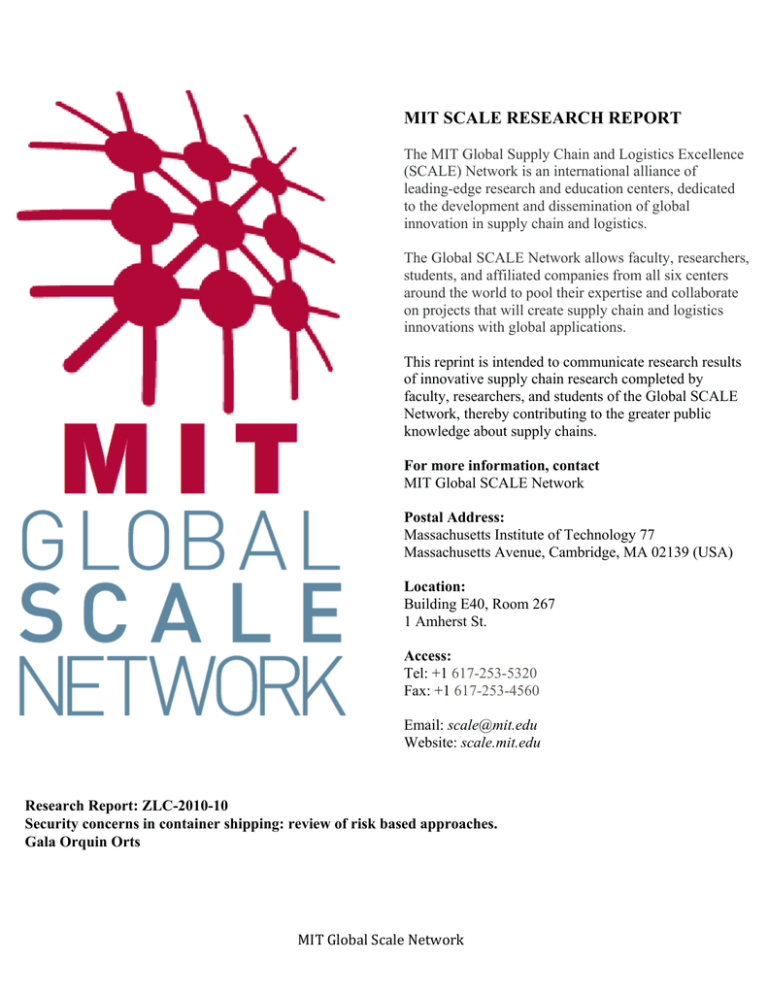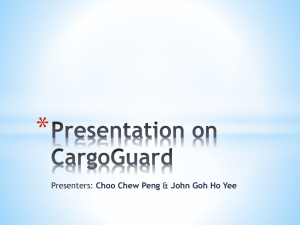MIT SCALE RESEARCH REPORT
advertisement

MIT SCALE RESEARCH REPORT The MIT Global Supply Chain and Logistics Excellence (SCALE) Network is an international alliance of leading-edge research and education centers, dedicated to the development and dissemination of global innovation in supply chain and logistics. The Global SCALE Network allows faculty, researchers, students, and affiliated companies from all six centers around the world to pool their expertise and collaborate on projects that will create supply chain and logistics innovations with global applications. This reprint is intended to communicate research results of innovative supply chain research completed by faculty, researchers, and students of the Global SCALE Network, thereby contributing to the greater public knowledge about supply chains. For more information, contact MIT Global SCALE Network Postal Address: Massachusetts Institute of Technology 77 Massachusetts Avenue, Cambridge, MA 02139 (USA) Location: Building E40, Room 267 1 Amherst St. Access: Tel: +1 617-253-5320 Fax: +1 617-253-4560 Email: scale@mit.edu Website: scale.mit.edu Research Report: ZLC-2010-10 Security concerns in container shipping: review of risk based approaches. Gala Orquin Orts MITGlobalScaleNetwork For Full Thesis Version Please Contact: Marta Romero ZLOG Director Zaragoza Logistics Center (ZLC) Edificio Náyade 5, C/Bari 55 – PLAZA 50197 Zaragoza, SPAIN Email: mromero@zlc.edu.es Telephone: +34 976 077 605 MITGlobalScaleNetwork Security concerns in container shipping: review of risk based approaches. By Gala Orquin Orts Thesis Advisor: Prof. Mustafa Cagri Gurbuz. Summary: This thesis tackles the question of security measures implemented at ports and their effects in the supply chain. Through simulation of the CSI security scheme, different inspection levels of containers are analyzed and the consequent safety stock levels calculated. The feasibility of 100% scanning of US bound containers remains unproven. Master of Engineering in Logistics and Supply Chain Management – MIT Zaragoza Logistics Centre, 2010. Master of Science in Management - Bordeaux Business School, 2007. INSERT KEY INSIGHTS YOUR 1. 100% inspection level would be hard to handle PHOTO at ports, especially with the queues created at gates. HERE 2. Due to longer port operations, lead times increase and companies need to bear higher safety stocks. Introduction Given that 20 million containers travel the world every year and few of them are physically inspected, it is very easy to illegally transport people, arms or even Weapons of Mass Destruction. Government Accountability Office’s investigators managed to import radioactive material to US using false documents. All developed technologies’ goals in the containerized global supply chain used to be the increase in efficiency in terms of cost and time. The main objective of these policies was the reduction in shrinkage and misrouting of the containers. Security in the transportation of material had never been the objective of any initiative, and the security measures in place at ports were not regulated by any international organisation. The fact that containers are visually anonymous and a very small fraction are physically inspected makes it easier for terrorists to use the supply chain to transport illegal materials around the world. Since the terrorist attacks on the World Trade Centre in 2001, the US has increasingly focused on developing security measures to avoid thefts and transportation of illegal materials. Many international programs initiated by the US, have been developed to reduce the vulnerability of the containerized supply chain. It has been estimated that the detonation of a nuclear weapon in a port could incur a cost in the range of $55 to $220 billion (Abt et al, 2003). If the material transported is not properly checked and the probability of intercepting an attack is not increased, the effects of terrorists’ attacks could become more frequent over time. Because of the attack on September 11, 2001, the US developed the 9/11 Act, which requires that by 2012, 100% of US bound containers, must be scanned at the port of embarkation. This requirement has caused much criticism regarding the costs and the additional delays incurred by this new procedure and its feasibility at foreign ports has not yet been proven. The aim of such policies is always to improve security, but the efficiency of the supply chain might be negatively influenced. Can the US requirements of 9/11 Act be met at international ports without having negative effects to the global trade? Because this question is too vast and the differences in ports make it impossible to generalise at global levels, this thesis only analyses the background and current situation at the international level. It also provides a summary of the most important international programs currently in place and evaluates the feasibility of the 100% scanning requirement under CSI security scheme. The logistics layer is composed by all the actors having access to the content of the container and the locations through which the cargo is moved. 3) The regulatory layer This layer can be viewed as the system that implements rules of behaviour through fines and duties through different agencies and organisations, as the Customs Office. As the purpose of these organisations is different, their agreement on implementing new international initiatives can be difficult and conflicts could arise. International initiatives The 3 layers of the Containerized Supply Chain The global supply chain is composed by different members through whom the raw materials are transformed into finished products and are delivered to customers. Once the freight is being transported via container many other players intervene in the supply chain. These actors can be vessels, port facilities, railcars, trucks and the proper container. These are called the physical components containing goods, information and financial flows. When the number of interventions increase in the handling of any container, it becomes harder to track the movements and to assign responsibilities within the supply chain. The supply chain can be divided in 3 different layers: the transaction layer, the logistics layer and the regulatory layer (Willis, 2004). These layers are interdependent and interacting networks. International initiatives to improve security have been developed in all three layers (Bichou, 2005). Standards of security have been specified and all actors must comply with the requirements in order to facilitate global trade. Container Security Initiative (CSI) This initiative was announced in January 2002, and it was one of the programs established after the September 11 2001 terrorists’ attacks. Its goal is to make the US ports the last line of defence and not the first as it was before. The core elements of this initiative are: 1) The transaction layer The transaction layer is based on information and physical flows between all the members of the supply chain. These members are connected between them through contracts, product specifications and transaction records that allow the correct movement of the freight. Simulation model 2) The logistics layer This layer can be seen as the conveyor through which the products are moved. This can be roads, trucks and sea lanes which compose a network, providing services to producers and consumers. The developed Arena model simulates the processes of inspection in the CSI security scheme from the arrival of a container to the port until its shipment. The objective of this model is to visualize the impact in the lead time and consequently in the Identify high risk containers with advanced information and technological tools. Pre-screen containers as early as possible in the supply chain before loading. safety stock of a company, by varying factors such as inspection percentage (M), equipment resources (N) and percentage of containers released after inspection (S). The different values tested are: λ / hr 100 TEU 50 TEU M (%) 5 15 25 N 2 3 4 S (%) 98 96,5 95 CSL (%) 95 90 Lead times at ports Conclusions 6 Days spent in the system The variability in the lead times affects directly the safety stock levels. With 2 inspection stations the lead time is higher but less variable than with more stations. The levels of safety stock are multiplied by more than 4 times if the inspection rate is 25%. The implementation of the 100% scanning would require companies to change their inventory policies or even change their sourcing strategy. 5 N=2 4 N=3 3 The feasibility of the 100% scanning remains doubtful as ports would be congested and containers delayed. N=4 2 1,5 days 1 The tradeoff between increasing security and influencing global trade should be further analyzed. 0 M = 5% M = 15% Cited Sources M = 25% With the assumption that containers arrive to the port 1.5 days prior to scheduled departure, we observe that the increase in the percentage of inspected containers makes the containers miss their vessel. The feasibility of the 100% scanning requirement would need the containers to arrive much earlier to the port. Queues at inspection stations 30000 25000 20000 N=2 15000 N=3 10000 N=4 5000 0 M = 5% M = 15% M = 25% For the number of equipments tested in the simulation, the average queues reach values as high as 45000 containers for 25% inspection rate. This issue is of major concern for big ports as they would become highly congested. The number of equipments seems to alleviate the system, but the length of the queues remains high. Safety stock levels 1.200.000 1.000.000 800.000 N=2 600.000 N=3 400.000 N=4 200.000 M = 5% M = 15% M = 25% Abt, C. C, Rhodes, W., Casagrande R., Gaumer G. 2003. The economic impacts of bioterrorist attacks on freight transport systems in an age of seaport vulnerability. Report, Abt Associates, Cambridge, MA. Bichou, K., 2005, Maritime Security: Framework, methods and Applications 2005. Report to UNCTAD, Geneva: UNCTAD, June 2005. Willis, HH &Ortiz, DS 2004, Evaluating the Security of the Global Containerized Supply Chain, RAND Corporation, Santa Monica.






